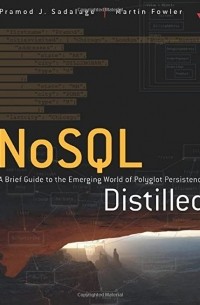
Автор
Pramod J. Sadalage – лучшие книги
По популярности
-
NoSQL Distilled: A Brief Guide to the Emerging World of Polyglot Persistence Pramod J. Sadalage, Martin Fowler
ISBN: 0321826620 Год издания: 2012 Издательство: Addison-Wesley Professional The need to handle increasingly larger data volumes is one factor driving the adoption of a new class of nonrelational “NoSQL” databases. Advocates of NoSQL databases claim they can be used to build systems that are more performant, scale better, and are easier to program. NoSQL Distilled is a concise but thorough introduction to this rapidly emerging technology. Pramod J. Sadalage and Martin Fowler explain how NoSQL databases work and the ways that they may be a superior alternative to a traditional RDBMS. The authors provide a fast-paced guide to the concepts you need to know in order to evaluate whether NoSQL databases are right for your needs and, if so, which technologies you should explore further. The first part of the book concentrates on core concepts, including schemaless data models, aggregates, new distribution models, the CAP theorem, and map-reduce. In the second part, the authors explore architectural and design issues associated with implementing NoSQL. They also present realistic use cases that demonstrate NoSQL databases at work and feature representative examples using Riak, MongoDB, Cassandra, and Neo4j. In addition, by drawing on Pramod Sadalage’s pioneering work, NoSQL Distilled shows how to implement evolutionary design with schema migration: an essential technique for applying NoSQL databases. The book concludes by describing how NoSQL is ushering in a new age of Polyglot Persistence, where multiple data-storage worlds coexist, and architects can choose the technology best optimized for each type of data access. -
Recipes for Continuous Database Integration Pramod J. Sadalage
Год издания: 2007 Издательство: Addison-Wesley Professional This is the eBook version of the printed book.
The past few years have seen the rise of agile or evolutionary methods in software development. These methods embrace change in requirements even late in the project. The ability to change software is because of certain practices that are followed within teams, such as Test Driven Development, Pair Programming, and Continuous Integration. Continuous Integration provides a way for software teams to integrate their work more than once a day, and promotes confidence in the software that is being developed by the team. It is thought that this practice is difficult to apply when continuously integrating the database with application code; hence, Evolutionary Database Development is considered a mismatch with agile methods. Pramod Sadalage shows that this is not necessarily true.
Continuous Integration changed the way software is written. Why not extend and make the database part of the same Continuous Integration cycle so that you can see integrated results of your application as well as your database? Delivered in PDF format for quick and easy access, Recipes for Continuous Database Integration shows how the database can be brought under the preview of Continuous Integration, allowing all teams to integrate not only their application code, but also their database.
This Short Cut presents a recipe for each task that needs to be done. Each recipe starts with a statement of a problem, followed by an explanation and solution. It provides concrete ways and examples to implement ideas in Refactoring Databases: Evolutionary Database Design by Scott W Ambler and Pramod Sadalage.
Table of Contents
What This Short Cut Covers
Introduction
Recipe 1 Continuously Integrating?
Recipe 2 Extracting Your Database in Scripts
Recipe 3 Using Version Control for Your Database
Recipe 4 Automating Database or Schema Creation
Recipe 5 Creating Objects in Your Database
Recipe 6 Removing Database Objects
Recipe 7 Removing Your Database
Recipe 8 Using the Build Property Files
Recipe 9 Re-Creating Your Application Database for Any Build
Recipe 10 Making It Easy for New Developers to Join the Team
Recipe 11 Integrating on Every Check-In
Recipe 12 Naming Upgrade Scripts
Recipe 13 Automating Database Change Script Creation
Recipe 14 Implementing Database Version Checking
Recipe 15 Sending Upgrades to Customers
Sample Code
Further Reading
About the Author
What’s in the Companion Book
Related Publication
-
Refactoring Databases: Evolutionary Database Design Scott W. Ambler, Pramod J. Sadalage
ISBN: 0321293533 Год издания: 2006 Издательство: Addison-Wesley Professional Refactoring has proven its value in a wide range of development projects—helping software professionals improve system designs, maintainability, extensibility, and performance. Now, for the first time, leading agile methodologist Scott Ambler and renowned consultant Pramodkumar Sadalage introduce powerful refactoring techniques specifically designed for database systems.
Ambler and Sadalage demonstrate how small changes to table structures, data, stored procedures, and triggers can significantly enhance virtually any database design—without changing semantics. You’ll learn how to evolve database schemas in step with source code—and become far more effective in projects relying on iterative, agile methodologies.
This comprehensive guide and reference helps you overcome the practical obstacles to refactoring real-world databases by covering every fundamental concept underlying database refactoring. Using start-to-finish examples, the authors walk you through refactoring simple standalone database applications as well as sophisticated multi-application scenarios. You’ll master every task involved in refactoring database schemas, and discover best practices for deploying refactorings in even the most complex production environments.
The second half of this book systematically covers five major categories of database refactorings. You’ll learn how to use refactoring to enhance database structure, data quality, and referential integrity; and how to refactor both architectures and methods. This book provides an extensive set of examples built with Oracle and Java and easily adaptable for other languages, such as C#, C++, or VB.NET, and other databases, such as DB2, SQL Server, MySQL, and Sybase.
Using this book’s techniques and examples, you can reduce waste, rework, risk, and cost—and build database systems capable of evolving smoothly, far into the future.


